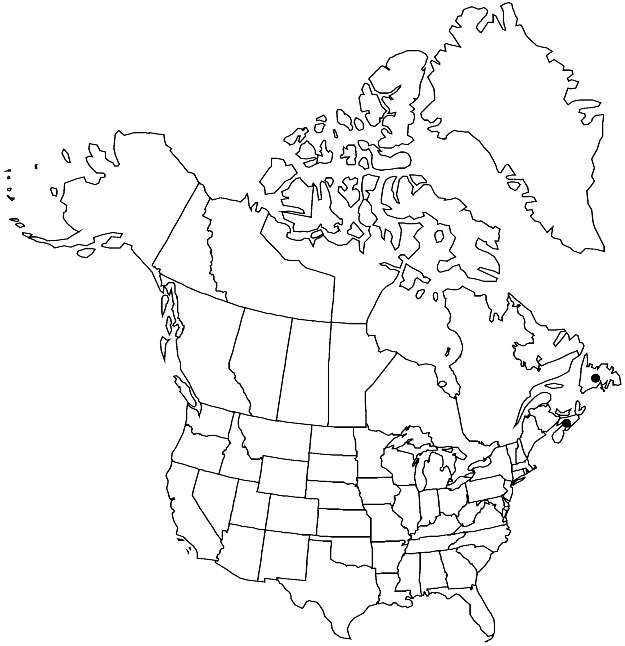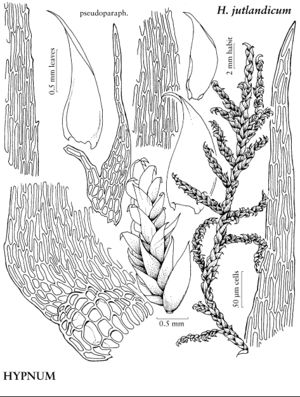Difference between revisions of "Hypnum jutlandicum"
Bot. Tidsskr. 65: 179. 1969.
FNA>Volume Importer |
FNA>Volume Importer |
||
| Line 29: | Line 29: | ||
|elevation=low to moderate elevations (0-500 m) | |elevation=low to moderate elevations (0-500 m) | ||
|distribution=Nfld. and Labr. (Nfld.);N.S.;Europe;Atlantic Islands (Azores). | |distribution=Nfld. and Labr. (Nfld.);N.S.;Europe;Atlantic Islands (Azores). | ||
| − | |discussion=<p>Hypnum jutlandicum is largely an amphi-Atlantic species that may occur in Alaska. The pale yellowish green, glossy, pinnate plants are very distinctive; they might be confused with H. imponens, but H. jutlandicum has yellow rather than red-brown stems and golden yellow rather than pale yellow leaves. The pseudoparaphyllia of H. imponens are more broadly foliose than the nearly filiform ones of H. jutlandicum. Distinction from H. cupressiforme is less apparent, but the usually more complanate pale green plants of H. jutlandicum are usually sufficient to separate it. Plants of H. jutlandicum have branches emerging in a horizontal plane; the pseudoparaphyllia are terminated by a 1-seriate tip of several elongate cells; the alar cells are usually strongly excavate and sometimes brown; and the distal laminal cells are subquadrate and 3–5(–7) along the margin.</p> | + | |discussion=<p><i>Hypnum jutlandicum</i> is largely an amphi-Atlantic species that may occur in Alaska. The pale yellowish green, glossy, pinnate plants are very distinctive; they might be confused with <i>H. imponens</i>, but <i>H. jutlandicum</i> has yellow rather than red-brown stems and golden yellow rather than pale yellow leaves. The pseudoparaphyllia of <i>H. imponens</i> are more broadly foliose than the nearly filiform ones of <i>H. jutlandicum</i>. Distinction from <i>H. cupressiforme</i> is less apparent, but the usually more complanate pale green plants of <i>H. jutlandicum</i> are usually sufficient to separate it. Plants of <i>H. jutlandicum</i> have branches emerging in a horizontal plane; the pseudoparaphyllia are terminated by a 1-seriate tip of several elongate cells; the alar cells are usually strongly excavate and sometimes brown; and the distal laminal cells are subquadrate and 3–5(–7) along the margin.</p> |
|tables= | |tables= | ||
|references= | |references= | ||
| Line 52: | Line 52: | ||
|publication year=1969 | |publication year=1969 | ||
|special status=Selected by author to be illustrated | |special status=Selected by author to be illustrated | ||
| − | |source xml=https://jpend@bitbucket.org/aafc-mbb/fna-data-curation.git/src/ | + | |source xml=https://jpend@bitbucket.org/aafc-mbb/fna-data-curation.git/src/8f726806613d60c220dc4493de13607dd3150896/coarse_grained_fna_xml/V28/V28_843.xml |
|genus=Hypnum | |genus=Hypnum | ||
|species=Hypnum jutlandicum | |species=Hypnum jutlandicum | ||
Revision as of 18:08, 18 September 2019
Plants small to medium-sized, pale green. Stems 4–10 cm, yellowish green to pale brown, creeping, ascending, or erect, strongly complanate-foliate, densely to sparsely pinnate, branches 0.4–0.7+ cm; hyalodermis absent, central strand weak; pseudoparaphyllia filamentous to lanceolate, occasionally 2-fid. Leaves loosely imbricate, straight to falcate-secund, ovate or oblong-lanceolate, gradually narrowed to apex, 1.7–2.2(–2.5) × 0.6–0.8(–0.9) mm; base not decurrent, not auriculate; margins plane or recurved basally, usually markedly serrulate distally; acumen short; costa double and short or indistinct; alar region not well defined; proximal cells somewhat enlarged and somewhat decurrent at extreme marginal cell; basal laminal cells shorter, broader than medial cells, light yellow or unpigmented, walls often porose; medial cells (60–)70–90(–100) × 3 µm. Sexual condition dioicous; inner perichaetial leaves oblong-lanceolate, margins distinctly serrulate in apex, costa indistinct. Sporophytes unknown in North America.
Habitat: Terrestrial
Elevation: low to moderate elevations (0-500 m)
Distribution

Nfld. and Labr. (Nfld.), N.S., Europe, Atlantic Islands (Azores).
Discussion
Hypnum jutlandicum is largely an amphi-Atlantic species that may occur in Alaska. The pale yellowish green, glossy, pinnate plants are very distinctive; they might be confused with H. imponens, but H. jutlandicum has yellow rather than red-brown stems and golden yellow rather than pale yellow leaves. The pseudoparaphyllia of H. imponens are more broadly foliose than the nearly filiform ones of H. jutlandicum. Distinction from H. cupressiforme is less apparent, but the usually more complanate pale green plants of H. jutlandicum are usually sufficient to separate it. Plants of H. jutlandicum have branches emerging in a horizontal plane; the pseudoparaphyllia are terminated by a 1-seriate tip of several elongate cells; the alar cells are usually strongly excavate and sometimes brown; and the distal laminal cells are subquadrate and 3–5(–7) along the margin.
Selected References
None.
